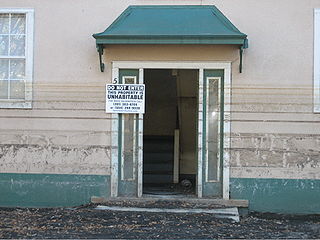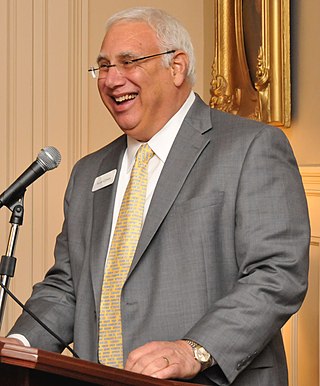
New Orleans is a consolidated city-parish located along the Mississippi River in the southeastern region of the U.S. state of Louisiana. With a population of 383,997 according to the 2020 U.S. census, it is the most populous city in Louisiana, third most populous city in the Deep South, and the twelfth-most populous city in the southeastern United States. Serving as a major port, New Orleans is considered an economic and commercial hub for the broader Gulf Coast region of the United States. New Orleans is also a region of French Louisiana, along with the Cajun Country.

Tulane University, officially the Tulane University of Louisiana, is a private research university in New Orleans, Louisiana. Founded as the Medical College of Louisiana in 1834 by seven young medical doctors, it was turned into a comprehensive public university as the University of Louisiana by the state legislature in 1847. The institution became private under the endowments of Paul Tulane and Josephine Louise Newcomb in 1884 and 1887. The Tulane University Law School and Tulane University Medical School are, respectively, the 12th oldest law school and 15th oldest medical school in the United States.

Dillard University is a private, historically black university in New Orleans, Louisiana. Founded in 1930 and incorporating earlier institutions founded as early as 1869 after the American Civil War, it is affiliated with the United Church of Christ and the United Methodist Church.

Hurricane Katrina was a devastating Category 5 Atlantic hurricane that caused 1,836 fatalities and damage estimated between $97.4 billion to $145.5 billion in late August 2005, particularly in the city of New Orleans and its surrounding area. At the time, it was the costliest tropical cyclone on record, later tied by Hurricane Harvey of 2017. Katrina was the twelfth tropical cyclone, the fifth hurricane, and the third major hurricane of the 2005 Atlantic hurricane season. It was also the fourth-most intense Atlantic hurricane to make landfall in the contiguous United States, gauged by barometric pressure.

As the center of Hurricane Katrina passed southeast of New Orleans on August 29, 2005, winds downtown were in the Category 1 range with frequent intense gusts. The storm surge caused approximately 23 breaches in the drainage canal and navigational canal levees and flood walls. As mandated in the Flood Control Act of 1965, responsibility for the design and construction of the city's levees belongs to the United States Army Corps of Engineers and responsibility for their maintenance belongs to the Orleans Levee Board. The failures of levees and flood walls during Katrina are considered by experts to be the worst engineering disaster in the history of the United States. By August 31, 2005, 80% of New Orleans was flooded, with some parts under 15 feet (4.6 m) of water. The famous French Quarter and Garden District escaped flooding because those areas are above sea level. The major breaches included the 17th Street Canal levee, the Industrial Canal levee, and the London Avenue Canal flood wall. These breaches caused the majority of the flooding, according to a June 2007 report by the American Society of Civil Engineers. The flood disaster halted oil production and refining which increased oil prices worldwide.
The article covers the Hurricane Katrina effects by region, within the United States and Canada. The effects of Hurricane Katrina, in late August 2005, were catastrophic and widespread. It was one of the deadliest natural disasters in U.S. history, leaving at least 1,836 people dead, and a further 135 missing. The storm was large and had an effect on several different areas of North America.

The reconstruction of New Orleans refers to the rebuilding process endured by the city of New Orleans after Hurricane Katrina destroyed much of the city on August 29, 2005. The storm caused levees to fail, releasing tens of billions of gallons of water. The levee failure contributed to extensive flooding in the New Orleans area and surrounding parishes. About 80% of all structures in Orleans Parish sustained water damage. Over 204,000 homes were damaged or destroyed, and more than 800,000 citizens displaced—the greatest displacement in the United States since the Dust Bowl of the 1930s. Wind damage was less severe than predicted. The damage that took place that needed to be repaired cost about $125 billion.

This article contains a historical timeline of the events of Hurricane Katrina' on August 23–30, 2005 and its aftermath.

The New Orleans Public Library (NOPL) is the public library service of the city of New Orleans, Louisiana, United States.

New Orleans East is the eastern section of New Orleans, Louisiana, the newest section of the city. This collection of diverse suburban neighborhoods represents 65% of the city's total land area, but it is geographically isolated from the rest of the city by the Inner Harbor Navigational Canal. It is surrounded by water on all sides, bounded by the Industrial Canal, Gulf Intracoastal Waterway, Lake Pontchartrain, Lake Borgne, and the Rigolets, a long deep-water strait connecting the two lakes. Interstate 10 (I-10) splits the area nearly in half, and Chef Menteur Hwy, Downman Rd, Crowder Blvd, Dwyer Rd, Lake Forest Blvd, Read Blvd, Bullard Ave, Michoud Blvd, Hayne Blvd, Morrison Rd, Bundy Rd, and Almonaster Ave serve as major streets and corridors.

Charity Hospital was one of two teaching hospitals which were part of the Medical Center of Louisiana at New Orleans (MCLNO), the other being University Hospital. Three weeks after the events of Hurricane Katrina, then-Governor Kathleen Blanco said that Charity Hospital would not reopen as a functioning hospital. The Louisiana State University System, which owns the building, stated that it had no plans to reopen the hospital in its original location. It chose to incorporate Charity Hospital into the city's new medical center in the lower Mid-City neighborhood. The new hospital completed in August 2015 was named University Medical Center New Orleans.

The Historic New Orleans Collection (THNOC) is a museum, research center, and publisher dedicated to the study and preservation of the history and culture of New Orleans and the Gulf South region of the United States. It is located in New Orleans' French Quarter. The institution was established in 1966 by General and Mrs. L. Kemper Williams to keep their collection of Louisiana materials intact and available for research and exhibition to the public.

As a result of Hurricane Katrina and its effects on New Orleans, Tulane University was closed for the second time in its history—the first being during the American Civil War. The university closed for four months during Katrina, as compared to four years during the Civil War.

John M. Barry is an American author and historian who has written books on the Great Mississippi Flood of 1927, the influenza pandemic of 1918, and the development of the modern form of the ideas of separation of church and state and individual liberty. He is a professor at the Tulane University School of Public Health and Tropical Medicine and Distinguished Scholar at Tulane's Bywater Institute.

Scott S. Cowen is president emeritus of Tulane University in New Orleans, Louisiana, where he was also Seymour S. Goodman Memorial Professor in the A.B. Freeman School of Business and professor of economics in Tulane's School of Liberal Arts. He was interim president of Case Western Reserve University in Cleveland, Ohio from 2020 to 2021, and currently serves as Distinguished Presidential Visiting Professor of Leadership and Management at CWRU. He has written more than a hundred peer-reviewed journal articles and five books. His most recent book, Winnebagos on Wednesdays: How Visionary Leadership Can Transform Higher Education, was published by Princeton University Press in 2018. Cowen is the eponym of Tulane's Cowen Institute and chairs its board of advisors. Cowen served as Tulane's 14th president from July 1998 through June 2014.
BELFOR is a multinational corporation that provides recovery and restoration services for structures damaged as a result of fires, floods, and other natural disasters.

Newcomb Art Museum of Tulane University is an art museum located in the Woldenberg Art Center on the campus of Tulane University in New Orleans, Louisiana, United States. It has been historically known for its significant collection of Newcomb Pottery and other crafts produced at Newcomb College, as well as administering the art collections of the university. Since 2014, the institution has increasingly focused on exhibitions and programs that explore socially engaged art, civic dialogue, and community transformation.

James Freret (1838–1897) was an American architect who practiced in New Orleans, Louisiana, prolific in designing many homes in that area.

Sandy Rosenthal is an American civic activist and founder of Levees.Org, an organization created in October 2005 to educate the American public about the cause of the levee failures and catastrophic flooding in New Orleans during Hurricane Katrina.

The Hogan Archive of New Orleans Music and New Orleans Jazz is an academic repository located at Tulane University in New Orleans, Louisiana. The archive specializes in Dixieland Jazz, gospel, blues, rhythm and blues, Creole songs, and related musical genres. Its collection includes oral histories, audio and video recordings, photos and other images, sheet music, personal papers, and teaching aids.

















